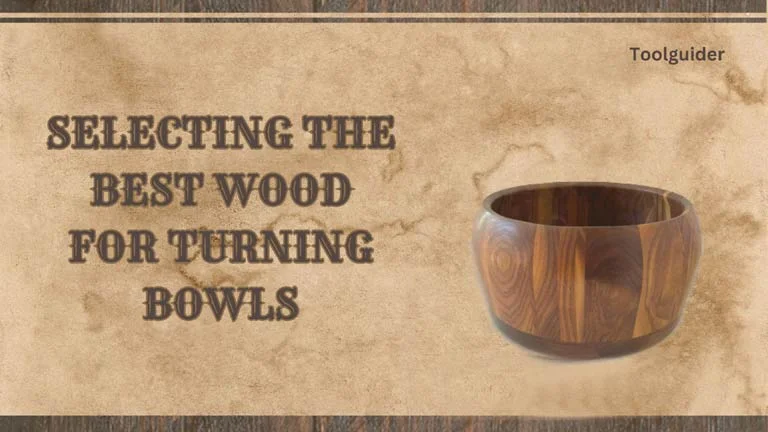Learn the art of choosing the best wood for turqning bowls. Explore the unique qualities of hardwoods, and softwoods so that your bowls turn out to be both functional and visually captivating.
Woodturning is a fascinating craft that transforms raw wood into functional and artistic pieces. When it comes to crafting bowls on a lathe, the choice of wood will significantly impact the final result bearing in mind factors such as grain patterns, hardness, and color.
What is turning bowl
A turning bowl is shaping a wooden bowl on a lathe. It is a popular form of woodworking where a piece of wood is rotated on a lathe creating a symmetrical and embellished bowl.
The selected wood blank is securely mounted on the lathe. The lathe rotates the wood to shape it with precision. The first step is to rough out the basic shape of the bowl using roughing gouges or other cutting tools.
At this stage, the excess material is removed to form a basic bowl shape. Once the bowl has taken shape, the surface is refined removing tool marks and giving a smooth finish using sandpaper and other finishing techniques.
Wood bowl turning needs skill, precision, and knowledge about wood traits. The artistry lies in visualizing the final form and working with the natural features of the wood. The result is an inimitable and functional piece of wood art.
Guide to the Best Woods for Turning Bowls
Maple is a sought-after choice due to its fine grain and light color. It turns well and can have intricate designs. It has a beautiful finish making it versatile for both functional and decorative bowls.
Mahogany’s reddish-brown color and fine grain make it an excellent choice for turning bowls. It turns smoothly and finishes well giving bowls a warm and sophisticated appearance.
Teak is known for its durability and resistance to moisture. Its golden-brown color and unique texture will create practical and aesthetically pleasing pieces.
Cherry wood has timeless appeal in the world of woodturning. It is well-known for its warm, reddish-brown hues. The color deepens with age giving character to the bowls. Walnut will be an excellent choice for those who want to go for a darker, more luxurious finish. Its rich, dark color and attractive grain patterns will make a stunning bowl.
The flowering cherry tree has a smooth finish and an appealing contrast between the smooth-turned surface and the retained natural bark on the rim. Its distinctive light color with darker streaks will make for an elegant bowl.
How to preserve turning bowls
Do not rapidly dry the bowl as it can lead to cracks and warping. Allow the turned bowl to dry gradually and evenly. Apply a wood sealer to seal the wood pores and create a barrier against moisture.
Food-safe finishes like mineral oil or walnut oil are suitable for bowls used with food while other finishes like polyurethane offer a durable protective layer. Apply multiple coats of finish letting each coat dry completely before applying the next. Multiple coats will provide a more robust protective layer and enhance the visual appeal of the bowl.
Store the bowls in a stable position to avoid warping. Keep away from direct sunlight as prolonged exposure causes fading and deterioration of the finish.
A chisel catch or improper use of turning tools can cause sudden stress on the wood leading to cracks. Utilize sharp tools with proper cutting techniques and at an appropriate speed to diminish the risk of accidents.
Green wood should be allowed to dry slowly and evenly to ease the stress on the wood fibers. If the wood dries too quickly it will have uneven shrinkage and lead to cracks.
Turning the bowl too thin makes it more prone to cracking. A uniform thickness throughout the bowl with gradual transitions reduces stress concentrations.
Turning Bowl criteria: Best Wood for turning bowls
Woods with a straight grain, fine texture, and consistent density are usually easier to work with, especially for intricate designs. Consider whether the bowl will serve a functional or purely decorative purpose. Some woods like fruitwoods are excellent for both functional and aesthetic bowls.
Hardwoods like maple, cherry, and oak are known for their durability and resistance to wear. Evaluate the wood’s durability especially if the bowl is intended for functional use. Choose woods that are known for their ease of turning.
Learn about the preferred wood’s resistance to moisture especially if the bowl will be in contact with liquids. Some woods like teak are naturally resistant to moisture and are suitable for kitchenware.
Buy wood locally or from sustainable forestry practices. This supports eco-friendly initiatives and adds a personal touch to your craftsmanship.
Challenges of turning Bowls
Wood has a natural propensity to move and change shape as it dries. This movement will lead to warping, and cracking in the turned bowl.
Improper tool utilization, catches or misjudgments will give tool marks, tear-out, or can cause accidents. For smooth cuts and precise shapes requires skill and practice.
Properly secure the bowl blank to the lathe (chucking) for safe and effective turning. Otherwise, inadequate mounting can result in vibrations, wobbling or the bowl will come loose during turning.
Designing a bowl with proportions and an aesthetically pleasing shape requires a good eye for symmetry and balance.
Wrap up
Remember, the best wood for turning bowls depends on features such as ease of turning, grain pattern, color, and how you wish to use them. Experiment with different woods to discover your penchants and create bowls that are not only functional but also visually captivating.
In the world of woodturning, the choice of wood can elevate a bowl from a simple turned object to a work of art. Whether opting for the timeless beauty of hardwoods, the unique patterns of teak wood or the sentimental value of local or salvaged wood, understand the advantages of different woods for having the desired outcome.
FAQ
The choice of wood significantly impacts the aftermath of a lathe-turned bowl. Green wood is more pliable and easier to work with on the lathe giving smoother cuts and reduced wear on your tools. Maple also stands out for its grain pattern and smooth finish.
You need to comprehend the characteristics of the wood you’re working with. When it comes to bowl turning, green hardwood (freshly cut and not yet dried) is preferred. It is readily available and you will find it at a lower cost. Experiment with different wood types for distinctive and visually appealing products.
For choosing the best finish for wood-turned bowls consider factors such as what you want to use the bowl for, the desired appearance and safety considerations especially if the bowl is for food. Some suggested options are:
● Pure Tung Oil
● Raw Linseed Oil
● Mineral Oil
● Beeswax
● Carnauba Wax
● Shellac
Fruit trees such as apple, pear, and cherry are prevalent choices for woodturning. Cherry wood has idiosyncratic grain patterns and can produce bowls with striking natural features. Olive wood is cherished for its exceptional grain patterns and can produce stunningly turning bowls.
As the wood dries, it may shrink unevenly leading to internal stress that can crack the bowl. This is especially common in green wood (freshly cut and not dried). There might be defects in the wood such as Knots, checks or hidden cracks making it prone to cracking.

I love all things tech, and I wear many hats – tech lover, business starter, digital marketer, and blogger. I know the ins and outs of Digital Marketing, SEO, SEM, SMM, and how to generate leads. My goal? Making things simple for you with clear guides and reviews. I stumbled upon WordPress while creating my first business site, and I fell in love with it right away. When I’m not building websites, creating content, or boosting clients’ online efforts, I’m focused on staying healthy, hanging out with family, and exploring the world. Connect with me on Facebook, Twitter, Linkedin, or read my complete biography.

